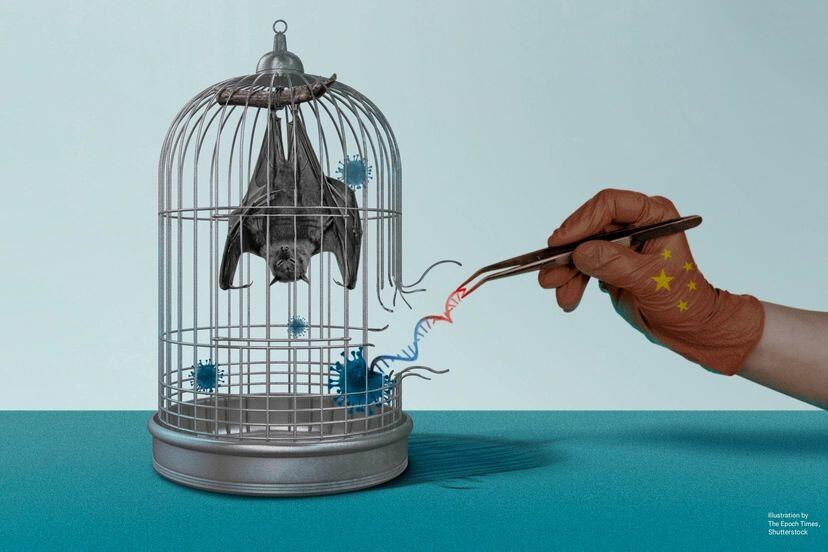There was two very different aspects to the 2020 Covid pandemic: The totalitarian excesses and the science. Not the one written by politicians in Brussels. That's ideology, the secular version of religion where you know the truth and only need total power to flush it down the throat of your constituents. The real and new science of gain of function applied to virus and other pathogens as originally and surreptitiously developed in the West, then in China when the risks became too high.
The totalitarian risk has dies down for now but the gain of function risk has not. Here's the story:
Authored by Yuhong Dong M.D., Ph.D. via The Epoch Times (emphasis ours),
We’re not afraid of the tigers in the zoo because we trust they cannot attack. But what if someone opens the cage?
Many viruses are highly lethal in nature but cannot infect humans. Fear arises when these viruses break the species barrier.
This can happen naturally or through risky research practices, particularly gain-of-function (GOF) research.
What Is GOF?
Just as all substances have functions, specific genes enable viruses to spread rapidly or cause severe diseases. GOF research involves introducing new functioning genes into a virus, enhancing its ability to infect hosts or increasing its virulence.
There are at least three main types of new functions a virus can gain:

- Expanded Host Range GOF research can enable viruses to infect new species that they previously could not. This includes crossing the species barrier to infect humans, which poses significant risks for zoonotic outbreaks and potential pandemics. A 2015 Nature Medicine article provides a pertinent example. A bat-derived SARS-like coronavirus, initially noninfectious to humans, became capable of human infection after GOF studies at China’s Wuhan Institute of Virology (WIV).
- Enhanced Transmission GOF research can result in viruses gaining the ability to spread more efficiently between hosts. This includes changes that allow a virus to be transmitted through new routes or, more effectively, through existing ones. In 2012, GOF research at the University of Wisconsin-Madison significantly transformed the H5N1 bird flu virus. Initially non-airborne, the virus acquired the ability to transmit through the air, demonstrating the profound impact of GOF studies on viral capabilities.
- Increased Virulence Viruses can gain mutations that make them more virulent, meaning they can cause more severe diseases in infected hosts. This can involve an enhanced ability to evade the host’s immune system or increased replication rates within the host. A 2022 preprint paper shows researchers at Boston University created a lethal version of the Omicron variant.
GOF can also be used to generate positive traits in germs. For example, by adding a human insulin gene, a germ gains the new function of producing insulin.
GOF Research of Concern
Because viral genes are relatively easy to edit, GOF studies frequently involve viruses. However, some of these studies carry significant risks and can lead to dire consequences.
The U.S. National Science Advisory Board for Biosecurity (NSABB) defines GOF research of concern as “research that can be reasonably anticipated to generate a pathogen with pandemic potential,” characterized by two attributes:
- Highly transmissible, with the potential to spread widely and uncontrollably among human populations
- Highly virulent and likely to cause significant morbidity and/or loss of human life
If accidentally released from a lab into the general population, such pathogens could cause uncontrollable hazards. Additionally, the military application of GOF falls within the scope of bioweapon threats.
Methods of GOF research generally include genetic editing, which involves directly modifying a virus’ genes, and reassortment, which involves combining genetic material from different viral strains to create new variants.
In reality, the scope of GOF research can be much broader. Due to viral genes’ highly variable and adaptable nature, even routine culturing of viruses in cells or animals can lead to unexpected genetic alterations.
Double-Edged Sword
Scientists often conduct GOF research to understand the viruses and develop drugs or vaccines.
While these reasons may sound scientifically justified, the main debate centers on the risks versus the assumed benefits. GOF research can theoretically aid in studying viral mechanisms and provide insights for developing drugs or vaccines. However, the associated risks are significant, particularly the potential to generate dangerous pathogens.
A decade ago, two published studies on bird flu viruses were conducted by a U.S. lab and a Dutch lab, sparking significant discussion.
Both studies were designed to better understand how the viruses’ genes could be modified to make them more transmissible in mammals. The goal was to help people better prepare for a potential future pandemic.
Unexpectedly, after both groups of researchers separately edited the genes of a deadly H5N1 bird flu virus, they produced new strains capable of easily spreading via air droplets between mammals.
The edited virus could spread more easily among mammals and became easier to transmit to humans.
“Why would scientists deliberately create a form of the H5N1 avian influenza virus that is probably highly transmissible in humans?” This critical question was raised in a 2012 Nature article.
Subsequently, in October 2014, U.S. authorities announced a “pause” on funding for 18 GOF studies involving influenza, MERS, or SARS viruses.
The pause was short-lived. In 2018, the U.S. National Institute of Allergy and Infectious Diseases and the Dutch Healthcare Authority approved funding for further GOF research, sparking another wave of objections. Harvard University epidemiologist Marc Lipsitch expressed concerns in a Science article, stating that scientists are being asked to “trust a completely opaque process where the outcome is to permit the continuation of dangerous experiments.”
Finally, after yielding to public pressure, investigators for the two research studies declined to renew the grants originally submitted for their GOF research. Consequently, such bird flu GOF studies were officially halted in the United States in 2020.
In the United States and most European countries, where scientists can express their opposing opinions, the development of GOF experiments faces multiple regulatory hurdles and ethical reviews.
However, in countries without these safeguards, the pursuit of GOF research could proceed unchecked, potentially putting the world at significant risk.

China’s Bird Flu GOF Research
Risky GOF studies on bird flu viruses in China have been underway since the 2010s.
In a study published in Science in May 2013, a group of scientists at Harbin Veterinary Research Institute in Harbin, China, conducted GOF research by combining the highly lethal but not easily transmissible H5N1 avian influenza virus, with the highly contagious H1N1 swine flu strain, which infected millions of people in 2009.
The resulting hybrid viruses were then tested for their ability to infect mammals, revealing the potential risks associated with such genetic manipulation of pathogens. This research underscored the dual-use nature of gain-of-function studies, highlighting both their potential to inform pandemic preparedness and the significant biosafety and biosecurity concerns they raise.
As a result, the researchers created a new, more virulent virus. An H5N1 hybrid strain, which integrated genes responsible for transmissibility from the H1N1 virus, acquired the capability to easily spread among guinea pigs through respiratory droplets.
In 2021, a collaborative project involving researchers from the United States, the United Kingdom, and China sought to enhance surveillance and vaccine development. While not explicitly labeled as a GOF study, these experiments conducted in a Chinese laboratory involved genetic modifications typical of GOF research.
The experiments used a routine viral laboratory research approach known as “serial passage,” which involves growing the virus from one cell or animal model to another. Viral mutations with greater transmissibility or pathogenicity can often be selected during this process. The animal models were also carefully chosen to reproduce the virus for specific research purposes. We’ve explained this in detail in a previous article.
Nonetheless, the most widely known GOF studies conducted in China involve research on coronaviruses.
Breaking the Barrier
Bats are known carriers or natural reservoirs of many viruses. Bat-hosting coronaviruses typically only infect bats or wild animals, not humans. However, this situation has changed with the advent of GOF research.
In 2015, a team of Chinese scientists conducted GOF studies on a bat coronavirus at the WIV, which is affiliated with the Chinese Academy of Sciences and under the administration and control of the Chinese Communist Party (CCP).
In this study, the researchers took the gene for spike protein—the spike-shaped structure on the surface of a virus—from a bat SARS-like virus and inserted it into the backbone of a SARS virus, the virus that caused the first pandemic of this century.
The newly created SARS-like virus, coded as SCH-014-MA15, could infect human airway cells and achieve a transmission similar to the SARS virus. It also gained the ability to infect mammals like mice and successfully cause lung diseases.

The WIV has also conducted other GOF research on bat SARS-like viruses with effective results.
According to a leaked 2014 NIH report, WIV researchers experimented on a natural bat coronavirus capable of binding with human ACE2 receptors, significantly increasing its potency. They used this bat virus to engineer three new chimeric coronaviruses.
The results showed that in the lungs of mice, these newly created coronaviruses produced far more virus particles—up to 10,000 times higher than the original virus.
Read more here...


No comments:
Post a Comment